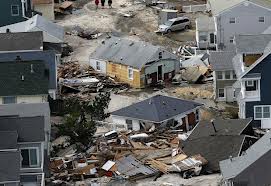While the US National Climate Assessment, released last month, puts the climate change impacts we’re already experiencing in the US in sharp relief, a new report is the first to calculate their financial risks and costs.
"With the oceans rising and the climate changing, the Risky Business report details the costs of inaction in ways that are easy to understand in dollars and cents – and impossible to ignore," says former NYC Mayor, Michael Bloomberg, who chairs the project.
Former Treasury Secretary Hank Paulson and Tom Steyer are the other leaders on the project.
Not surprisingly, their main conclusion is that "the US faces significant and diverse economic risks from climate change," with specific, measurable impacts on our nation’s current assets and ongoing economic activity…" if we don’t act aggressively.
The report focuses on the most obvious and economically significant risks: Damage to coastal property and infrastructure from rising sea levels and increased storm surges, climate-driven changes in agricultural production and energy demand, and the impact of higher temperatures on labor productivity and public health.
Unlike any other study, it drills down geographically, quantifying costs down to even county levels in some cases.
Once in the atmosphere, carbon dioxide stays there for centuries – therefore, decisions made today have a big impact on the future. Each year that goes by without action broadens and deepens the risks.
Staying On the Current Path Produces:
- Large-scale losses of coastal property and infrastructure: by 2050, $66 billion to $106 billion worth of coastal property will likely be below sea level nationwide, growing to $238 billion to $507 billion by 2100. There’s a 1 in 20 chance, the numbers are much higher – $701 billion.
Property losses will be concentrated along the Atlantic coast.

- Extreme heat threatens human health, energy systems and labor productivity, particularly in the Southwest, Southeast, and Upper Midwest. By 2050, the average American will likely experience double to triple the days of over 95°F each year and people living in these key regions will see several months of this level of heat.
By 2100, there will be periods where the "Humid Heat Stroke Index" is so high that the human body can no longer maintain a normal core temperature without air conditioning, especially for people that work outdoors – they will face severe health risks and potential death. High demand for air conditioning will strain grid capacity and drive up energy costs.
- Agricultural patterns and crop yields shift with likely gains for farmers in the north and losses in the lower Great Plains and South on the order of 50-70%.
- Much higher temperatures will demand much more energy – up to 95 gigawatts of new generation over the next 5-25 years – the equivalent of about 200 coal/ natural gas power plants. It will cost ratepayers up to $12 billion a year.
"It is our hope that it becomes standard practice for the American business and investment community to factor climate change into its decision-making process," they say, noting that we are already seeing this response from the agricultural and national security sectors, and starting to see it in bond markets and utilities." Businesses, however, are responding only to the extent of how these risks impact short term financial and planning decisions.
"We also know the private sector doesn’t operate in a vacuum, and that the economy runs most smoothly when government sets a consistent policy and a regulatory framework within which business has the freedom to operate. Right now, cities and businesses are scrambling to adapt to a changing climate without sufficient federal government support." They call on American businesses to play an active role in shaping federal policy to set the rules on how best to react to the risks and costs posed by climate change, in order to move lock-step in a sustainable direction.
Read Risky Business, where you can review their findings for each US region:
